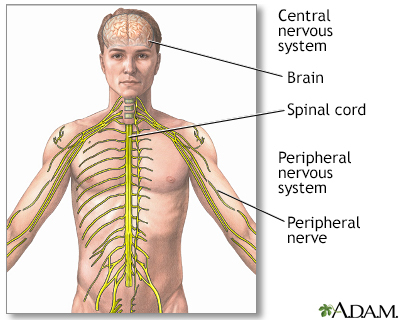Pseudotumor cerebri syndrome
Definition
Idiopathic intracranial hypertension (IIH) is a condition in which the pressure inside the skull is increased. The brain is affected in a way that the condition appears to be, but is not, a tumor.
Alternative Names
Pseudotumor cerebri syndrome; Benign intracranial hypertension
Causes
The condition occurs more often in women than men, especially in young obese women 20 to 40 years old. It is rare in infants, but can occur in children. Before puberty, it occurs equally in boys and girls.
The cause is unknown.
Certain medicines can increase the risk of developing this condition. These medicines include:
- Amiodarone
- Birth control pills such as levonorgestrel (Norplant)
- Cyclosporine
- Cytarabine
- Growth hormone
- Isotretinoin
- Levothyroxine (children)
- Lithium carbonate
- Minocycline
- Nalidixic acid
- Nitrofurantoin
- Phenytoin
- Steroids (starting or stopping them)
- Sulfa antibiotics
- Tamoxifen
- Tetracycline
- Certain drugs that contain Vitamin A, such as cis-retinoic acid (Accutane)
The following factors are also related to this condition:
- Down syndrome
- Behcet disease
- Chronic kidney failure
- Endocrine (hormone) disorders such as Addison disease, Cushing disease, hypoparathyroidism, polycystic ovary syndrome
- Following treatment (embolization) of an arteriovenous malformation
- Infectious diseases such as HIV/AIDS, Lyme disease, following chickenpox in children
- Iron deficiency anemia
- Obesity
- Obstructive sleep apnea
- Pregnancy
- Sarcoidosis (inflammation of the lymph nodes, lungs, liver, eyes, skin, or other tissues)
- Systemic lupus erythematosis
- Turner syndrome
Symptoms
Symptoms may include any of the following:
- Headaches, throbbing, daily, irregular and worse in the morning
- Neck pain
- Blurred vision
- Buzzing sound in the ears (tinnitus)
- Dizziness
- Double vision (diplopia)
- Nausea, vomiting
- Vision problems such as flashing or even loss of vision
- Low back pain, radiating along both legs
Headaches may get worse during physical activity, especially when you tighten the stomach muscles during coughing or straining.
Exams and Tests
The health care provider will perform a physical exam. Signs of this condition include:
- Bulging anterior fontanelle in infants
- Increased head size in infants
- Swelling of the optic nerve in the back of the eye (papilledema)
- Inward turning of the eye toward the nose (sixth cranial, or abducens, nerve palsy)
Even though there is increased pressure in the skull, there is no change in alertness.
Tests that may be done include:
- Funduscopic examination
- CT scan of the head
- Eye exam, including visual field testing
- MRI of the head with MR venography
- Lumbar puncture (spinal tap)
Diagnosis is made when other health conditions are ruled out. These include conditions that may cause increased pressure in the skull, such as:
- Hydrocephalus
- Tumor
- Venous sinus thrombosis
- Infection
Treatment
Treatment is aimed at the cause of IIH. The main goal of treatments is to preserve vision and reduce the severity of headaches.
A lumbar puncture (spinal tap) can help relieve pressure in the brain and prevent vision problems. Repeat lumbar punctures are helpful for pregnant women in order to delay surgery until after delivery.
Other treatments may include:
- Fluid or salt restriction
- Medicines such as corticosteroids, acetazolamide, furosemide, and topiramate
- Shunting procedures to relieve pressure from spinal fluid buildup
- Surgery to relieve pressure on the optic nerve
- Weight loss
- Treatment of the underlying disease, such as vitamin A overdose
People will need to have their vision closely monitored. There can be vision loss, which is sometimes permanent. Follow-up MRI or CT scans may be done to rule out problems such as tumors or hydrocephalus (buildup of fluid inside the skull).
In some cases, the pressure inside the brain remains high for many years. Symptoms can return in some people. A small number of people have symptoms that slowly get worse and lead to blindness.
Outlook (Prognosis)
The condition sometimes disappears on its own within 6 months. Symptoms can return in some people. A small number of people have symptoms that slowly get worse and lead to blindness.
Possible Complications
Vision loss is a serious complication of this condition.
When to Contact a Medical Professional
Contact your provider if you or your child has any of the symptoms listed above.
Gallery

References
Alrobaian M, Miller NR. Pseudotumor cerebri. In: Winn HR, ed. Youmans and Winn Neurological Surgery. 8th ed. Philadelphia, PA: Elsevier; 2023:chap 189.
Rosenberg GA. Brain edema and disorders of cerebrospinal fluid circulation. In: Jankovic J, Mazziotta JC, Pomeroy SL, Newman NJ, eds. Bradley and Daroff's Neurology in Clinical Practice. 8th ed. Philadelphia, PA: Elsevier; 2022:chap 88.
Safier RA, Cleves-Bayon C, Gaesser J. Neurology. In: Zitelli BJ, McIntire SC, Nowalk AJ, Garrison J, eds. Zitelli and Davis' Atlas of Pediatric Physical Diagnosis. 8th ed. Philadelphia, PA: Elsevier, 2023:chap 16.
